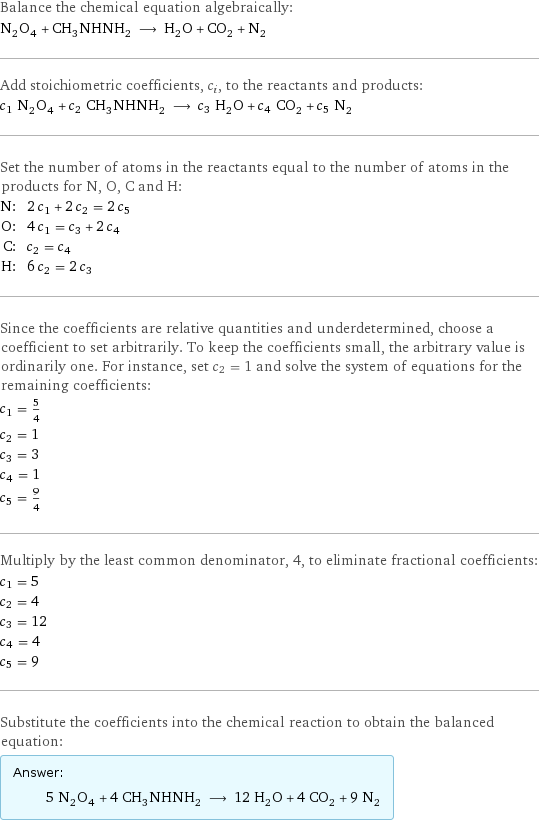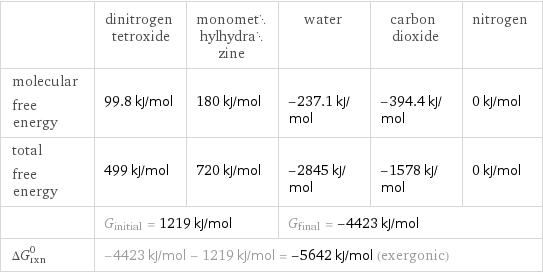Input interpretation

N_2O_4 dinitrogen tetroxide + CH_3NHNH_2 monomethylhydrazine ⟶ H_2O water + CO_2 carbon dioxide + N_2 nitrogen
Balanced equation

Balance the chemical equation algebraically: N_2O_4 + CH_3NHNH_2 ⟶ H_2O + CO_2 + N_2 Add stoichiometric coefficients, c_i, to the reactants and products: c_1 N_2O_4 + c_2 CH_3NHNH_2 ⟶ c_3 H_2O + c_4 CO_2 + c_5 N_2 Set the number of atoms in the reactants equal to the number of atoms in the products for N, O, C and H: N: | 2 c_1 + 2 c_2 = 2 c_5 O: | 4 c_1 = c_3 + 2 c_4 C: | c_2 = c_4 H: | 6 c_2 = 2 c_3 Since the coefficients are relative quantities and underdetermined, choose a coefficient to set arbitrarily. To keep the coefficients small, the arbitrary value is ordinarily one. For instance, set c_2 = 1 and solve the system of equations for the remaining coefficients: c_1 = 5/4 c_2 = 1 c_3 = 3 c_4 = 1 c_5 = 9/4 Multiply by the least common denominator, 4, to eliminate fractional coefficients: c_1 = 5 c_2 = 4 c_3 = 12 c_4 = 4 c_5 = 9 Substitute the coefficients into the chemical reaction to obtain the balanced equation: Answer: | | 5 N_2O_4 + 4 CH_3NHNH_2 ⟶ 12 H_2O + 4 CO_2 + 9 N_2
Structures

+ ⟶ + +
Names

dinitrogen tetroxide + monomethylhydrazine ⟶ water + carbon dioxide + nitrogen
Reaction thermodynamics
Gibbs free energy

| dinitrogen tetroxide | monomethylhydrazine | water | carbon dioxide | nitrogen molecular free energy | 99.8 kJ/mol | 180 kJ/mol | -237.1 kJ/mol | -394.4 kJ/mol | 0 kJ/mol total free energy | 499 kJ/mol | 720 kJ/mol | -2845 kJ/mol | -1578 kJ/mol | 0 kJ/mol | G_initial = 1219 kJ/mol | | G_final = -4423 kJ/mol | | ΔG_rxn^0 | -4423 kJ/mol - 1219 kJ/mol = -5642 kJ/mol (exergonic) | | | |
Entropy

| dinitrogen tetroxide | monomethylhydrazine | water | carbon dioxide | nitrogen molecular entropy | 304.3 J/(mol K) | 166 J/(mol K) | 69.91 J/(mol K) | 214 J/(mol K) | 192 J/(mol K) total entropy | 1521 J/(mol K) | 664 J/(mol K) | 838.9 J/(mol K) | 856 J/(mol K) | 1728 J/(mol K) | S_initial = 2185 J/(mol K) | | S_final = 3423 J/(mol K) | | ΔS_rxn^0 | 3423 J/(mol K) - 2185 J/(mol K) = 1237 J/(mol K) (endoentropic) | | | |
Equilibrium constant
![Construct the equilibrium constant, K, expression for: N_2O_4 + CH_3NHNH_2 ⟶ H_2O + CO_2 + N_2 Plan: • Balance the chemical equation. • Determine the stoichiometric numbers. • Assemble the activity expression for each chemical species. • Use the activity expressions to build the equilibrium constant expression. Write the balanced chemical equation: 5 N_2O_4 + 4 CH_3NHNH_2 ⟶ 12 H_2O + 4 CO_2 + 9 N_2 Assign stoichiometric numbers, ν_i, using the stoichiometric coefficients, c_i, from the balanced chemical equation in the following manner: ν_i = -c_i for reactants and ν_i = c_i for products: chemical species | c_i | ν_i N_2O_4 | 5 | -5 CH_3NHNH_2 | 4 | -4 H_2O | 12 | 12 CO_2 | 4 | 4 N_2 | 9 | 9 Assemble the activity expressions accounting for the state of matter and ν_i: chemical species | c_i | ν_i | activity expression N_2O_4 | 5 | -5 | ([N2O4])^(-5) CH_3NHNH_2 | 4 | -4 | ([CH3NHNH2])^(-4) H_2O | 12 | 12 | ([H2O])^12 CO_2 | 4 | 4 | ([CO2])^4 N_2 | 9 | 9 | ([N2])^9 The equilibrium constant symbol in the concentration basis is: K_c Mulitply the activity expressions to arrive at the K_c expression: Answer: | | K_c = ([N2O4])^(-5) ([CH3NHNH2])^(-4) ([H2O])^12 ([CO2])^4 ([N2])^9 = (([H2O])^12 ([CO2])^4 ([N2])^9)/(([N2O4])^5 ([CH3NHNH2])^4)](../image_source/af9646fb694d56999db6304150a7a38c.png)
Construct the equilibrium constant, K, expression for: N_2O_4 + CH_3NHNH_2 ⟶ H_2O + CO_2 + N_2 Plan: • Balance the chemical equation. • Determine the stoichiometric numbers. • Assemble the activity expression for each chemical species. • Use the activity expressions to build the equilibrium constant expression. Write the balanced chemical equation: 5 N_2O_4 + 4 CH_3NHNH_2 ⟶ 12 H_2O + 4 CO_2 + 9 N_2 Assign stoichiometric numbers, ν_i, using the stoichiometric coefficients, c_i, from the balanced chemical equation in the following manner: ν_i = -c_i for reactants and ν_i = c_i for products: chemical species | c_i | ν_i N_2O_4 | 5 | -5 CH_3NHNH_2 | 4 | -4 H_2O | 12 | 12 CO_2 | 4 | 4 N_2 | 9 | 9 Assemble the activity expressions accounting for the state of matter and ν_i: chemical species | c_i | ν_i | activity expression N_2O_4 | 5 | -5 | ([N2O4])^(-5) CH_3NHNH_2 | 4 | -4 | ([CH3NHNH2])^(-4) H_2O | 12 | 12 | ([H2O])^12 CO_2 | 4 | 4 | ([CO2])^4 N_2 | 9 | 9 | ([N2])^9 The equilibrium constant symbol in the concentration basis is: K_c Mulitply the activity expressions to arrive at the K_c expression: Answer: | | K_c = ([N2O4])^(-5) ([CH3NHNH2])^(-4) ([H2O])^12 ([CO2])^4 ([N2])^9 = (([H2O])^12 ([CO2])^4 ([N2])^9)/(([N2O4])^5 ([CH3NHNH2])^4)
Rate of reaction
![Construct the rate of reaction expression for: N_2O_4 + CH_3NHNH_2 ⟶ H_2O + CO_2 + N_2 Plan: • Balance the chemical equation. • Determine the stoichiometric numbers. • Assemble the rate term for each chemical species. • Write the rate of reaction expression. Write the balanced chemical equation: 5 N_2O_4 + 4 CH_3NHNH_2 ⟶ 12 H_2O + 4 CO_2 + 9 N_2 Assign stoichiometric numbers, ν_i, using the stoichiometric coefficients, c_i, from the balanced chemical equation in the following manner: ν_i = -c_i for reactants and ν_i = c_i for products: chemical species | c_i | ν_i N_2O_4 | 5 | -5 CH_3NHNH_2 | 4 | -4 H_2O | 12 | 12 CO_2 | 4 | 4 N_2 | 9 | 9 The rate term for each chemical species, B_i, is 1/ν_i(Δ[B_i])/(Δt) where [B_i] is the amount concentration and t is time: chemical species | c_i | ν_i | rate term N_2O_4 | 5 | -5 | -1/5 (Δ[N2O4])/(Δt) CH_3NHNH_2 | 4 | -4 | -1/4 (Δ[CH3NHNH2])/(Δt) H_2O | 12 | 12 | 1/12 (Δ[H2O])/(Δt) CO_2 | 4 | 4 | 1/4 (Δ[CO2])/(Δt) N_2 | 9 | 9 | 1/9 (Δ[N2])/(Δt) (for infinitesimal rate of change, replace Δ with d) Set the rate terms equal to each other to arrive at the rate expression: Answer: | | rate = -1/5 (Δ[N2O4])/(Δt) = -1/4 (Δ[CH3NHNH2])/(Δt) = 1/12 (Δ[H2O])/(Δt) = 1/4 (Δ[CO2])/(Δt) = 1/9 (Δ[N2])/(Δt) (assuming constant volume and no accumulation of intermediates or side products)](../image_source/ee7f023f3b0517bd0e39be4f6987b811.png)
Construct the rate of reaction expression for: N_2O_4 + CH_3NHNH_2 ⟶ H_2O + CO_2 + N_2 Plan: • Balance the chemical equation. • Determine the stoichiometric numbers. • Assemble the rate term for each chemical species. • Write the rate of reaction expression. Write the balanced chemical equation: 5 N_2O_4 + 4 CH_3NHNH_2 ⟶ 12 H_2O + 4 CO_2 + 9 N_2 Assign stoichiometric numbers, ν_i, using the stoichiometric coefficients, c_i, from the balanced chemical equation in the following manner: ν_i = -c_i for reactants and ν_i = c_i for products: chemical species | c_i | ν_i N_2O_4 | 5 | -5 CH_3NHNH_2 | 4 | -4 H_2O | 12 | 12 CO_2 | 4 | 4 N_2 | 9 | 9 The rate term for each chemical species, B_i, is 1/ν_i(Δ[B_i])/(Δt) where [B_i] is the amount concentration and t is time: chemical species | c_i | ν_i | rate term N_2O_4 | 5 | -5 | -1/5 (Δ[N2O4])/(Δt) CH_3NHNH_2 | 4 | -4 | -1/4 (Δ[CH3NHNH2])/(Δt) H_2O | 12 | 12 | 1/12 (Δ[H2O])/(Δt) CO_2 | 4 | 4 | 1/4 (Δ[CO2])/(Δt) N_2 | 9 | 9 | 1/9 (Δ[N2])/(Δt) (for infinitesimal rate of change, replace Δ with d) Set the rate terms equal to each other to arrive at the rate expression: Answer: | | rate = -1/5 (Δ[N2O4])/(Δt) = -1/4 (Δ[CH3NHNH2])/(Δt) = 1/12 (Δ[H2O])/(Δt) = 1/4 (Δ[CO2])/(Δt) = 1/9 (Δ[N2])/(Δt) (assuming constant volume and no accumulation of intermediates or side products)
Chemical names and formulas

| dinitrogen tetroxide | monomethylhydrazine | water | carbon dioxide | nitrogen formula | N_2O_4 | CH_3NHNH_2 | H_2O | CO_2 | N_2 Hill formula | N_2O_4 | CH_6N_2 | H_2O | CO_2 | N_2 name | dinitrogen tetroxide | monomethylhydrazine | water | carbon dioxide | nitrogen IUPAC name | | methylhydrazine | water | carbon dioxide | molecular nitrogen